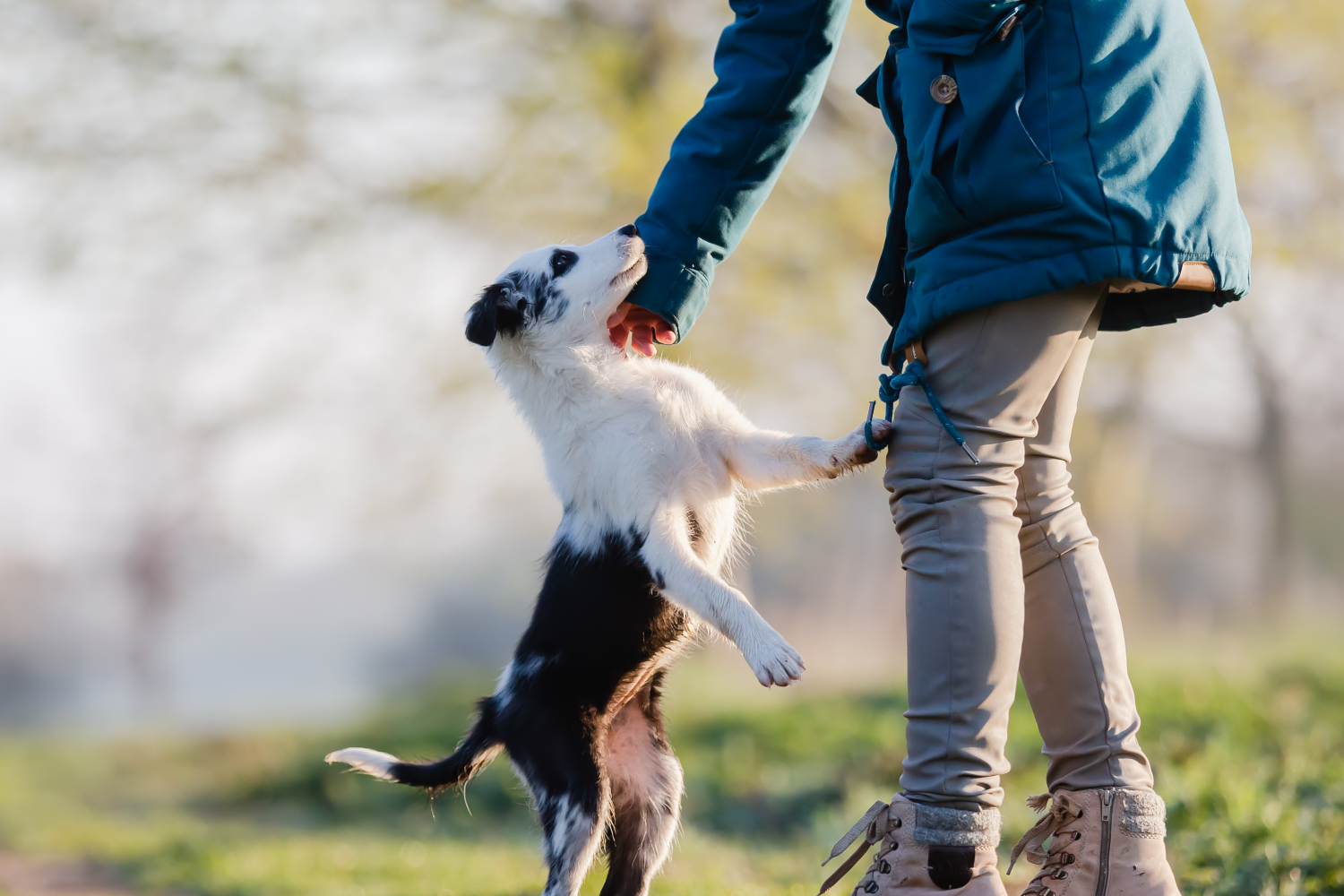
BOGO: buy a box of Longevity15 and get Yummy Combs free!
Shop now and get the BOGO deal today!
Joseph Roetheli, PhD

Highlights:
Dogs that jump are trying to communicate with you, but this behavior is problematic.
Training your dog to stop jumping will take time and clear commands, but your dog can learn to break this behavior.
Effective training, combined with exercise, nutrient-dense food, and a longevity-supportive supplement like Longevity15™, can help keep your dog thriving.
You love your dog, but not everyone who comes through your front door loves their behavior. If your dog regularly greets you and others by jumping on them, you may find yourself with fewer visitors and a dog that constantly gets their paw prints on your clothing.
Dogs that jump are not bad. They are simply dogs that have not been taught a better and more appropriate means of communicating with their humans. In dog language, this method of jumping up places them closer to your face and helps them get your attention. Jumping up is also a way that dogs greet humans and let them know they are excited to see them.
The following tips can help you break your dog of jumping while giving them a better method of communicating with you so that you can both enjoy a better, stronger relationship.
The first rule for breaking your dog’s jumping habit is to completely ignore them when they jump. This means no lifting your knee to block their jump, grabbing their paws, or forcing them down.
Yes, it can be annoying, especially if your dog is large and their jumps virtually knock you over, but giving them any attention, even if it is negative, is still attention. Plus, your dog may interpret your attempts to remove their paws or push them away as an invitation to play or roughhouse.
After your day at work, or even after you’ve only been gone five minutes, your dog is happy to see you. They want to greet you and be greeted. This is normal behavior and a way for you and your dog to bond.
However, greeting you should not involve jumping. When you enter the house, choose a command your dog can follow that says they are ready to be greeted.
This could be something like “paws on the floor,” sit,” or “down.” Only when they have responded to this command should you greet them, but make sure you give the command as soon as you walk in.
While training your dog, you’ll give the command you’ve chosen as soon as you enter the house, and repeat it until your dog obeys. Only after your dog obeys should you greet your dog and engage with them.
Before they obey (while they are actively jumping or not responding to the command), avoid making eye contact, touching them, or doing anything other than repeating the command.
Scattering a few training treats on the ground as soon as you or a guest enters your home can be an easy way to trick your dog into keeping their paws on the floor. As soon as you enter, toss a few treats on the ground and repeat the command you have chosen (like “sit”).
Your dog can’t eat treats from the floor and jump on you simultaneously, which may allow you some time to reinforce the command and allow them to respond to it.
Training your dog to avoid jumping won’t work unless it is practiced continually, and with every guest who enters your home. For expected guests, talk with them about ignoring your dog until they have responded to the command.
For unexpected guests, the treat trick can help, but you may also find it easier to send your dog to their bed or crate before you answer the door. This can help you avoid the need to tell your new visitor how to respond to your dog while your dog is actively jumping on them.
Once your dog has mastered greeting you properly, practice with close friends and family. Ask a friend to come over and help you train your dog by coming in and out of the door, ringing the doorbell, and knocking.
These triggers may send your dog into full jump mode, so practicing how to behave around others can be useful. Make sure the person you choose to help you isn’t afraid of your dog and understands clearly how to behave (avoiding the dog when they jump, giving attention when they do not) while you are practicing.
Some dogs immediately jump and place their paws in your lap when you sit down. This is typically a response to you coming into the home or a visitor coming into your home, and not the same as your dog jumping into your lap for a cuddle.
If this happens, stand up, but do so safely so your dog is not hurt. Only stand if your dog has placed paws only on your lap. If your dog has jumped into your lap, place the dog on the floor and stand up, and then give the command you’ve chosen to remind them of the property greeting behavior.
For large dogs that have the potential to knock people over when they jump, using a leash may be the most effective training method. In addition to using the command you’ve chosen, when a visitor enters your home, keep your dog on a leash for the first 15 minutes.
This helps your dog master the appropriate behavior while you are able to easily redirect them if they attempt to jump on the guest.
It’s never a good idea to strike your dog or yell at them. Dogs simply do not understand why you are striking them.
As their pack leader, spanking them or yelling at them creates distrust and can even breed aggression. For dogs, spanking and yelling do not reinforce positive behavior or cause your dog to understand that a certain behavior is bad. This type of correction can harm the bond between you and your dog.
Training takes time and patience. Keep working with your dog every day to curb their jumping and reinforce the new way they should behave when there are visitors. In time, you’ll be able to expect that your dog will remember to sit, stay, or remain calm anytime someone enters your house.
Your dog’s behavior isn’t bad or good, it’s just dog behavior. Molding that behavior so that it is acceptable to humans takes time and effort.
In addition to keeping your dog well-behaved, you can encourage their longevity by adding Longevity15 to their diets. Only Longevity15 helps support your dog’s wellness from a cellular level. Good behavior + long lives = lots of belly rubs, tail wags, and happy memories.
Sources:
Expert Tips on How to Stop a Dog From Jumping Up | American Kennel Club.org
How to Stop Your Dog From Jumping Up | Humane World.org
How To Stop Your Dog From Jumping | PetMD
Puppy Behavior & Socialization | Lawndale Veterinary Hospital
Updates, coupons, deals, and more!
Type anything...
We use cookies to provide you the best possible experience on our website. You consent to the usage of cookies by continuing to view our website. See our Privacy Notice for more information.